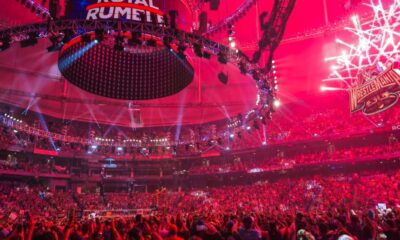Trop Talk, part three: I-175 and transportation
Editor’s note: In this multi-part series, the Catalyst will compare and contrast each of the seven proposals for the Tropicana Field site according to five major redevelopment needs that each plan was asked to meet: commercial and office space, housing, I-175 and transportation, parks and green space and hotel and convention center space.
The topic of today’s installment, the third in the series, is the future of Interstate 175 and the transportation network around the Trop site. The City of St. Petersburg’s request for proposals cited “connections to transportation” and compliance with its Complete Streets policy as two qualities it would look for in each proposal.
Intentional or not, the construction of I-175 raised a physical barrier that only served to widen the divide between the predominantly white northern part of St. Pete and the predominantly Black south side. The 1.3-mile spur cut off the once-thriving Deuces Live Main Street business district from the Gas Plant neighborhood and downtown St. Pete. To add insult to the injury of the city’s Black community, the Gas Plant district was then razed, in the late 1980s, to make room for Tropicana Field.
Now, with a once-in-a-generation redevelopment opportunity staring it in the face, the city has a chance to right some historical wrongs. While not taking a firm position on whether I-175 should be demolished, the Florida Department of Transportation — just one of the agencies that would need to sign off — has signaled that it would consider such a change.
Some of the seven proposals for the Trop site do indeed hinge on the removal of I-175, while others would leave the freeway in place but make more creative use of the space under and around it. In this article, we’ll take a look at each one’s stance on I-175 as well as the other transportation network upgrades they would provide.
The transportation enhancements outlined in the proposal by Sugar Hill Community Partners and JMA Ventures take full advantage of the removal of I-175. “We propose a comprehensive reconnection of the street grid at 14th, 12th, 11th, and 10th streets and reclamation of the approximately 20 acres currently occupied by the spur as a graceful boulevard and additional development,” their plan reads. Until such time as I-175 is removed, Sugar Hill and JMA are proposing the construction of a new footbridge across the freeway to make it safer for pedestrians. Running from Booker Creek to Campbell Park, the footbridge would consist of a wide greenway that includes bike lanes and pedestrian paths that pass through lush plantings.
Land underneath the freeway would also be put to better use. “Under I-275,” their proposal states, “a new pop-up art park will connect to the Warehouse Arts District and Deuces Live. Local artists, found in collaboration with the St. Pete Arts Alliance, will be invited to activate what is now underutilized space with murals and interventions.”
Sugar Hill and JMA Ventures also propose turning Fifth Avenue South into a “grand boulevard” that would better link downtown to the Warehouse Arts District, while Third Avenue South would be a traffic-calming through street
Wendover Housing Partners’ proposal does not take into account the potential removal of I-175, but it does call for widening and lengthening several streets and avenues. Under its plan, 15th Street would be extended to 5th Avenue South, while 16th Street would be substantially widened. Second Avenue South, Third Avenue South and Fourth Avenue South would all be extended eastward to Booker Creek from where they connect to 16th Street.
Portman Holdings and Third Lake Partners’ proposal would extend Third Avenue South all the way through the Trop site, creating what it calls an arts corridor that would also serve as a direct route from downtown St. Pete to the Warehouse Arts District. If a new Rays stadium is built on the property, Third Avenue South would be closed to vehicle traffic on game days. “The expanded pedestrian realm and plazas along Third Avenue will play host to a living museum of exhibitions, installations and murals realized in collaboration with local artists and cultural organizations,” their proposal states.
Like Wendover’s plan, Portman and Third Lake’s vision for the Trop site does not hinge on the removal of I-175. Instead, they would create a “new landmark garden bridge” over the freeway to Campbell Park; however, their proposal extols the benefits of converting the I-175 corridor to a ground-level, pedestrian- and bicycle-friendly boulevard.
I-175 would not be removed or scaled back in the proposal submitted by TRS Development Services, which calls for the construction of a 12-story, 60,000-square-foot intermodal transportation hub and parking garage at the intersection of 16th Street and First Avenue South, a parcel that, if a new baseball stadium is not built, would instead be dedicated to a senior housing complex. TRS would also create a wellness trail along Booker Creek that would be outfitted with several bike-rental “transition points.”
Midtown Development’s “Creekside” proposal, if chosen, would see most of the streets and avenues around the Trop site extended in accordance with the city’s Complete Streets policy. Specifically, it aims to “knit the city together again and re-integrate the Tropicana site with the rest of the grid system.” Creekside does not imagine a future without I-175 but would feature a “Heritage Bridge” connecting the new neighborhood to Campbell Park. The bridge, according to Midtown’s proposal, would include “landscaping, bike paths and pedestrian paths in an elegant park-like sinuous form. While the bridge addresses the challenge of crossing the freeway, it is a larger symbol of bridging the past with the future, connecting the disenfranchised to become part of the larger whole again.”
Though it does not go into detail, the Creekside proposal also mentions the construction of a tunnel underneath I-175 that would offer an additional connection to South St. Pete. As well, it calls for the development of a multi-modal transit hub where First Avenue South meets 13th Street. Additionally, and again without offering many specifics, Midtown said its Creekside plan would make better use of land beneath I-175.
Unicorp National Developments’ “Petersburg Park” proposal would replace a large portion of I-175 with a greenway park that would extend eastward into Roser Park and the city’s Innovation District. Like many of the other proposals, Petersburg Park would also feature a new pedestrian bridge over the freeway to provide easier access to Campbell Park and the south side. Third Avenue South, meanwhile, would become a promenade that runs through most of the development, terminating at Sunburst Plaza in the southwest corner of the Trop site, assuming a new Rays stadium is built there.
If a new ballpark is not in the cards, Third Avenue South would follow the same route but terminate at a mixed-use parcel that includes a conference center, residences and commercial and retail spaces. Eleventh and 15th streets would also be extended southward as part of the Petersburg Park vision.
The proposal submitted by Storage Rentals of America and Holabird & Root also looks ahead to a time when I-175 doesn’t cut off South St. Pete from downtown. Phase three of the plan, slated to commence in 2030, would see a variety of elements take the place of the demolished freeway. Moving from west to east, there would be mixed-use residential and commercial buildings, a technical or higher education campus, a series of canals and a large native landscape park. Under the SROA/Holabird & Root proposal, some but not all of the streets and avenues surrounding the Trop site would be extended. Fifteenth and 14th streets would be lengthened, for example, to add more north-south thoroughfares to the grid system.
Visit the City of St. Petersburg’s website to view all of the proposals and submit comments about them.






Tom
February 14, 2021at5:48 pm
I’ve lived near the Gas Plant neighborhood for almost 50 years and don’t quite see how the interstate cut off access to the 22nd Street business district. As I recall these were separated by a residential area. We patronized 22nd Street before and after the highway was built. Web’s City was across the street from Gas Plant and drew most of the business.
Displacement of residents moved customers away.
The malls opened and more business was lost. Illegal segregation ended and customers had more options.
Many of us opposed the loss of the Gas Plant neighborhood, and later the Dome and I-275. We sued for an environmental impact statement but lost. Now that this is all built I hope this taxpayer investment is not wasted without replacing it with something much better.